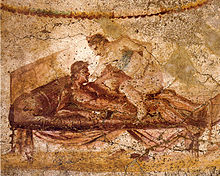Lupanar (Pompeii)
The Lupanar ( Regio VII, 12, 18 ) is a former brothel that has been archaeologically developed and made accessible in ancient Pompeii . It was discovered and excavated in 1862.
The building is at the crossroads of side streets, like many of the other facilities of this type found in Pompeii. The peculiarity of this establishment is that it was probably the only one built from the beginning exclusively for its purpose, the practice of prostitution . Sexual services were also offered in a number of taverns, mostly in one or two back rooms or upstairs. Examples are the caupona of Soterius (Regio I, 12, 3), a caupona with a flat (Regio I, 10, 2) or the Caupona of Asellina (Regio IX, 11,2). In the latter, as is often the case, canvassing for candidates for political office was carried out. Another brothel in its own house could have been the Casa degli Amanti .
As the plastering of the building in one cell showed impressions of impressed coins from the corresponding period, it is concluded that the house was probably completely renovated after AD 72.
The building is two-story, it has five cells and a latrine in the basement and another five cells on the upper floor. Inside, a wooden staircase led to the upper floor, the cells can be reached from the surrounding and overhanging balcony. The house has two entrances, nos. 18 and 19. The cells were each lockable with a wooden door.
Each cell was provided with a short, brick bed with a headboard, on which a mattress was placed. The numerous erotic frescoes found in almost every room show the types of lovemaking that was sold here at the time. A number of the representations are no longer on site, but in the National Archaeological Museum in Naples , where they were kept in a secret collection that was not accessible to the public until the 1970s.
About 120 inscriptions were found in and on the building, which indicates the high frequency of visitors to the house. The content of the graffiti is quite clear, so it says: hic eg (o) puellas multas futui (“I fucked a lot of girls here”) or Murtis bene / fel (l) as (“Myrtle, you blow well”). Inscriptions by the prostitutes themselves were also found, for example: fututa sum hic (“this is where I was fucked”). A number of names of the girls and women who work here are known, around half of them had Greek first names, which does not necessarily indicate their origin.
In the house itself, not only female prostitutes seem to have been active, there is an inscription: pedicare volo (“I'm looking for a boy”).
The average price was two aces , but depending on the performance, up to 16 aces. Sexually transmitted diseases were already known in antiquity , albeit rarely: Distillatio me tenet (“The gonorrhea caught me”).
The building and the frescoes were last restored between 2004 and 2006 for around 200,000 euros.
literature
- Robert Etienne: Pompeii - Life in an Ancient City. Reclam, Stuttgart 1974. Quoted from the Gutenberg Book Guild edition, Frankfurt / Vienna / Zurich 1978, ISBN 3-7632-2217-0 .
- Filippo Coarelli (ed.): Lübbe's archaeological guide Pompeii. Güstav Lübbe Verlag, Bergisch Gladbach 1979, ISBN 3-7857-0228-0 .
- Michael Grant: Art and Life in Pompeii and Herculaneum. Amber Verlag, Munich 1982, ISBN 3-922954-01-4 .
Web links
- Pictures (VII, 12, 18) , (VII, 12, 19) , (VII, 12, 20) at pompeiiinpictures (English)
Individual evidence
- ↑ Michael Grant: Art and Life in Pompeii and Herculaneum , p. 24.
- ↑ Filippo Coarelli (ed.): Lübbe's archaeological guide Pompeji , p. 302.
- ↑ Filippo Coarelli (ed.): Lübbe's archaeological guide Pompeji , p. 208.
- ↑ CIL 4, 7873 ; CIL 4, 7862 ; CIL 4, 7866 and CIL 4, 7863 ; see. Robert Etienne: Pompeii - Life in an Ancient City , p. 133.
- ↑ Filippo Coarelli (ed.): Lübbe's archaeological guide Pompeji , p. 188.
- ↑ Michael Grant: Art and Life in Pompeii and Herculaneum , p. 161.
- ↑ Filippo Coarelli (ed.): Lübbe's archaeological guide Pompeji , p. 302.
- ↑ CIL 4, 2175 .
- ↑ Translations after Filippo Coarelli (ed.): Lübbes archaeological guide Pompeji , p. 303.
- ↑ CIL 4, 2273 .
- ↑ CIL 4, 2217 .
- ↑ Filippo Coarelli (ed.): Lübbe's archaeological guide Pompeji , p. 303.
- ↑ CIL 4, 2210 .
- ↑ CIL 4, 8918 .
Coordinates: 40 ° 45 ′ 0.9 ″ N , 14 ° 29 ′ 12.4 ″ E

